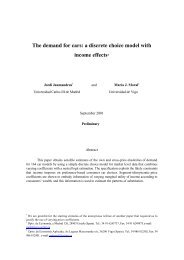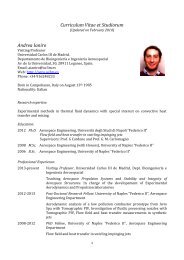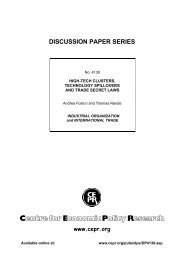- Page 1:
TESIS DOCTORALBIO-INSPIRED DECISION
- Page 7 and 8:
AgradecimientosSon muchas las veces
- Page 9 and 10:
AbstractRobotics is an emergent fie
- Page 11 and 12:
ResumenLa robótica es un área eme
- Page 13 and 14:
ContentsAgradecimientosAbstractResu
- Page 15 and 16:
5 The social robot Maggie and its d
- Page 18 and 19:
9.4 Harm/interactions with Alvaro d
- Page 20 and 21:
3.10 An overview of the net of syst
- Page 23:
List of Algorithms6.1 Object Q-Lear
- Page 26 and 27:
xxii
- Page 28 and 29:
2 Chapter 1. IntroductionFigure 1.1
- Page 30 and 31:
4 Chapter 1. Introductionautonomous
- Page 32 and 33:
6 Chapter 1. IntroductionAs in othe
- Page 34 and 35:
8 Chapter 1. Introductiondesired ou
- Page 36 and 37:
10 Chapter 1. Introduction1.4 Overv
- Page 38 and 39:
12 Chapter 1. Introduction
- Page 40 and 41:
14 Chapter 2. Biological foundation
- Page 42 and 43:
16 Chapter 2. Biological foundation
- Page 44 and 45:
18 Chapter 2. Biological foundation
- Page 46 and 47:
20 Chapter 2. Biological foundation
- Page 48 and 49:
22 Chapter 2. Biological foundation
- Page 50 and 51:
24 Chapter 2. Biological foundation
- Page 52 and 53:
26 Chapter 2. Biological foundation
- Page 54 and 55:
28 Chapter 2. Biological foundation
- Page 56 and 57:
30 Chapter 2. Biological foundation
- Page 58 and 59:
32 Chapter 2. Biological foundation
- Page 60 and 61:
34 Chapter 2. Biological foundation
- Page 62 and 63:
36 Chapter 2. Biological foundation
- Page 64 and 65:
38 Chapter 3. State of the Artand b
- Page 66 and 67:
40 Chapter 3. State of the Art(a) R
- Page 68 and 69:
42 Chapter 3. State of the Artpatie
- Page 70 and 71:
44 Chapter 3. State of the Art(a) i
- Page 72 and 73:
46 Chapter 3. State of the Artrange
- Page 74 and 75:
48 Chapter 3. State of the Artwell
- Page 76 and 77:
50 Chapter 3. State of the Artthe a
- Page 78 and 79:
52 Chapter 3. State of the ArtThe e
- Page 80 and 81:
54 Chapter 3. State of the Arttask.
- Page 82 and 83:
56 Chapter 3. State of the Artthe r
- Page 84 and 85:
58 Chapter 3. State of the Artit is
- Page 86 and 87:
60 Chapter 3. State of the Artthe r
- Page 88 and 89:
62 Chapter 3. State of the Artnon-l
- Page 90 and 91:
64 Chapter 3. State of the ArtTAME
- Page 92 and 93: 66 Chapter 3. State of the ArtMinsk
- Page 94 and 95: 68 Chapter 3. State of the Art
- Page 96 and 97: 70 Chapter 4. The Decision Making S
- Page 98 and 99: 72 Chapter 4. The Decision Making S
- Page 100 and 101: 74 Chapter 4. The Decision Making S
- Page 102 and 103: 76 Chapter 4. The Decision Making S
- Page 104 and 105: 78 Chapter 4. The Decision Making S
- Page 106 and 107: 80 Chapter 4. The Decision Making S
- Page 108 and 109: 82 Chapter 4. The Decision Making S
- Page 110 and 111: 84 Chapter 4. The Decision Making S
- Page 112 and 113: 86 Chapter 4. The Decision Making S
- Page 114 and 115: 88 Chapter 5. The social robot Magg
- Page 116 and 117: 90 Chapter 5. The social robot Magg
- Page 118 and 119: 92 Chapter 5. The social robot Magg
- Page 120 and 121: 94 Chapter 5. The social robot Magg
- Page 122 and 123: 96 Chapter 5. The social robot Magg
- Page 124 and 125: 98 Chapter 5. The social robot Magg
- Page 126 and 127: 100 Chapter 5. The social robot Mag
- Page 128 and 129: 102 Chapter 5. The social robot Mag
- Page 130 and 131: 104 Chapter 5. The social robot Mag
- Page 132 and 133: 106 Chapter 5. The social robot Mag
- Page 134 and 135: 108 Chapter 5. The social robot Mag
- Page 136 and 137: 110 Chapter 6. Learning to make dec
- Page 138 and 139: 112 Chapter 6. Learning to make dec
- Page 140 and 141: 114 Chapter 6. Learning to make dec
- Page 144 and 145: 118 Chapter 6. Learning to make dec
- Page 146 and 147: 120 Chapter 6. Learning to make dec
- Page 148 and 149: 122 Chapter 6. Learning to make dec
- Page 150 and 151: 124 Chapter 6. Learning to make dec
- Page 152 and 153: 126 Chapter 6. Learning to make dec
- Page 154 and 155: 128 Chapter 7. Implementing the dec
- Page 156 and 157: 130 Chapter 7. Implementing the dec
- Page 158 and 159: 132 Chapter 7. Implementing the dec
- Page 160 and 161: 134 Chapter 7. Implementing the dec
- Page 162 and 163: 136 Chapter 7. Implementing the dec
- Page 164 and 165: 138 Chapter 7. Implementing the dec
- Page 166 and 167: 140 Chapter 7. Implementing the dec
- Page 168 and 169: 142 Chapter 7. Implementing the dec
- Page 170 and 171: 144 Chapter 7. Implementing the dec
- Page 172 and 173: 146 Chapter 7. Implementing the dec
- Page 174 and 175: 148 Chapter 7. Implementing the dec
- Page 176 and 177: 150 Chapter 7. Implementing the dec
- Page 178 and 179: 152 Chapter 7. Implementing the dec
- Page 180 and 181: 154 Chapter 7. Implementing the dec
- Page 182 and 183: 156 Chapter 7. Implementing the dec
- Page 184 and 185: 158 Chapter 7. Implementing the dec
- Page 186 and 187: 160 Chapter 7. Implementing the dec
- Page 188 and 189: 162 Chapter 7. Implementing the dec
- Page 190 and 191: 164 Chapter 7. Implementing the dec
- Page 192 and 193:
166 Chapter 8. Testing the experime
- Page 194 and 195:
168 Chapter 8. Testing the experime
- Page 196 and 197:
170 Chapter 8. Testing the experime
- Page 198 and 199:
172 Chapter 8. Testing the experime
- Page 200 and 201:
174 Chapter 8. Testing the experime
- Page 202 and 203:
176 Chapter 8. Testing the experime
- Page 204 and 205:
178 Chapter 9. Experimental Results
- Page 206 and 207:
180 Chapter 9. Experimental Results
- Page 208 and 209:
182 Chapter 9. Experimental Results
- Page 210 and 211:
184 Chapter 9. Experimental Results
- Page 212 and 213:
186 Chapter 9. Experimental Results
- Page 214 and 215:
188 Chapter 9. Experimental Results
- Page 216 and 217:
190 Chapter 9. Experimental Results
- Page 218 and 219:
192 Chapter 9. Experimental Results
- Page 220 and 221:
194 Chapter 9. Experimental Results
- Page 222 and 223:
196 Chapter 9. Experimental Results
- Page 224 and 225:
198 Chapter 10. Conclusions and Fut
- Page 226 and 227:
200 Chapter 10. Conclusions and Fut
- Page 228 and 229:
202 Chapter 10. Conclusions and Fut
- Page 230 and 231:
204 Chapter 10. Conclusions and Fut
- Page 232 and 233:
206 Chapter 10. Conclusions and Fut
- Page 234 and 235:
208 Bibliography[8] M. A. Martínez
- Page 236 and 237:
210 Bibliography[35] B. Hardy-Vall
- Page 238 and 239:
212 Bibliography[63] J. LeDoux, “
- Page 240 and 241:
214 Bibliography[90] C. Bartneck an
- Page 242 and 243:
216 Bibliography[115] B. Graf, U. R
- Page 244 and 245:
218 Bibliography[140] W. P. Lee, J.
- Page 246 and 247:
220 Bibliography[166] C. Isbell, C.
- Page 248 and 249:
222 Bibliography[190] M. A. Salichs






